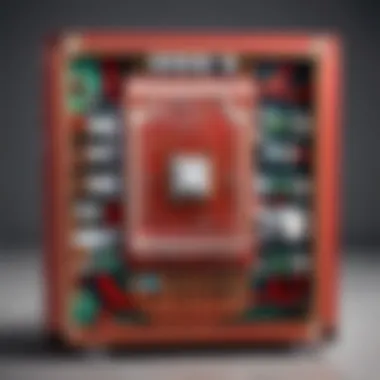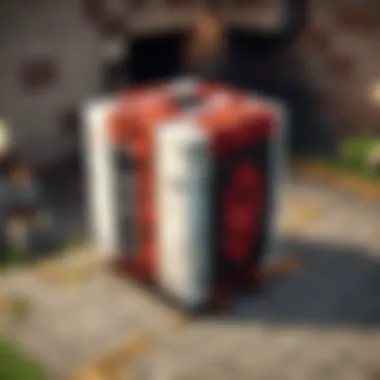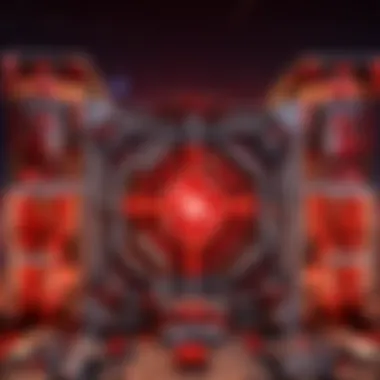Mastering Logical Inverters in Minecraft Redstone Mechanics


Intro
In the enchanting world of Minecraft, players often engage with intricate systems comprising redstone mechanisms. An essential component of these systems is the logical inverter. Understanding how this basic yet vital element operates is crucial for those wishing to build complex contraptions and devices.
Logical inverters, also called NOT gates, serve a single function—they invert an input signal. Whenever something affects this input, such as a lever switch, the output signal reacts accordingly, either being turned off or on. As players become familiar with these components, new avenues for creativity and advanced building techniques begin to open up. This is where both novice and seasoned gamers find value in mastering the logical inverter.
In this discussion, we will uncover the principles and practical uses of the logical inverter. We aim to empower players from all backgrounds with the insights needed to better incorporate this component into their redstone builds. From its function to its applications in various setups, the approach will be comprehensive, seeking to demystify the role it plays in Minecraft’s broader mechanical framework.
Minecraft Game Guides
Redstone Mechanics Explained
Redstone mechanics are foundational to creating automated machines and circuits within the game. Players often rely on a variety of components, including repeaters, comparators, and, of course, logical inverters.
At its core, redstone behaves much like wiring in real life. A current through redstone dust or blocks represents an
Prelude to Logical Inverters
The topic of logical inverters is vital for understanding more complex systems in Minecraft Redstone mechanics. This section introduces key principles that underlie logical inverters. Their functioning is not merely theoretical; these components are fundamental for creating intricate contraptions within the game world. Gamers of all levels, from beginners to experts, can greatly benefit from mastering logical inverters. This understanding leads to enhanced creativity and execution in their builds.
Definition of a Logical Inverter
A logical inverter is a device that takes an input signal and flips it, generating the opposite output. If you provide a 'true' input, the logical inverter delivers a 'false' output, and vice versa. This simple mechanism relies on the NOT operator from Boolean algebra, where the output is always the inverse of the input. InMinecraft, logical inverters can be created using Redstone components like torches, blocks, and Redstone dust.
Relevance in Minecraft Redstone
Logical inverters are critically important in Minecraft for several reasons.
- Building Complexity: They enable players to add levels of complexity to their Redstone creations.
- Signal Control: By using logical inverters, it is easier to control when circuits are active or inactive, thus permitting refined control over mechanisms.
- Facilitating Combinations: These devices can combine with other logic gates such as AND and OR gates. This combined functionality extends the potential of a player’s architectural or mechanical designs immensely.
- Design Versatility: Players can creatively incorporate inverters in various builds, influencing everything from traps and doors to expansive automated systems.
Proper implementation of logical inverters can lead to more efficient designs and aesthetically pleasing builds.
Understanding the role of inverters allows players to streamline their approaches, making processes flow more naturally within their circuits.
Basic Principles of Logic Gates
Understanding the basic principles of logic gates is crucial in utilizing the Redstone mechanics of Minecraft. Logic gates form the foundation of creating complex circuits, enabling players to manipulate various in-game elements efficiently. These gates process inputs and determine outputs based on logical operations. By mastering these principles, players can enhance their builds, create automation, and solve intricate problems within the game.
Understanding Logic Gates
Logic gates are a fundamental concept in computer science and electronics. In Minecraft, they mirror this concept using the game's Redstone system. Each gate conducts operations on signals received, either allowing or inhibiting them based on set conditions. The primary gate functions found in Minecraft are AND, OR, and NOT gates.
Each gate type serves a different purpose, and their combinations enable limitless possibilities. Presented logically within the game, players can construct efficient and creative mechanisms. The basic understanding boosts one's capability to innovate functional structures, such as traps or automated farming systems.
Types of Logic Gates
Various gates each accommodate unique conditions and effects. As players become familiar with their operations, the development of intricate systems becomes far easier. The practicality of these gates peaks when they are interconnected to create progressively sophisticated devices. Here are the primary types:
AND Gate
The AND gate is a fundamental logic gate that requires two or more inputs to be true for it to provide a true output. It's critical when you need multiple conditions to be satisfied simultaneously. The ability to connect connections makes its utility broad in advanced projects.
- Key Characteristic: This gate exclusively functions when all its inputs reflect true conditions.
- Why is it Beneficial: Its strictness makes the behaviors predictable, thus enabling a reliable mechanism.
- Unique Feature: In Redstone, the AND gate delivers a solid output only upon satisfying preconditions, adding necessary robustness to interactions.
- Advantages/Disadvantages: Efficient for controlling multi-factor interactions. However, it may limit flexibility since all inputs must align.


OR Gate
OR gates utilize an inclusive logic, providing a positive output if at least one input is active. This flexibility often leads to common applications in less rigid designs, where conditions vary. Thus, it is indispensable in many setups.
- Key Characteristic: The broad applicability allows many signal paths to result in output activation, expanding operational scope.
- Why is it Beneficial: Setups that employ OR gates can forgive variations or abnormalities without compromising overall function, promoting resilience in builds.
- Unique Feature: The ability to work even with partial criteria enriches its use, leading to multifunctional devices in gameplay.
- Advantages/Disadvantages: Its versatility provides expansive potential; however, it may lead to unintentional triggers if conditions overlap.
NOT Gate
The NOT gate serves as a simple logic inverter. It flips the input value; a true signal becomes a false signal and vice versa. This feature enables reverse conditions in intricate designs. Both distinct and essential, NOT gates lend unique functionality adds depth to circuitry management.
- Key Characteristic: The simplicity of the NOT gate delivers indispensable simplicity and clarity in operations.
- Why is it Beneficial: Ensuring that something remains disengaged while telling elsewhere to engage creates spatial solutions for players.
- Unique Feature: It functions just with one input where the output is inversely proportional, thus simplifying external connecting clusters.
- Advantages/Disadvantages: While it is significantly helpful for negating commands in logic sequences, its simplicity sometimes results in overly basic formations.
Familiarity with these gates empowers strategies within builds. Logic gates are keys to reveal potentials invisible before. Understanding each type’s unique attributes profoundly influences successful design breakthroughs for any Minecraft player.
How Logical Inverters Operate
Understanding how logical inverters operate is fundamental to mastering Redstone circuitry in Minecraft. These components serve as crucial building blocks for achieving complex functions. An inverter strengthens players' ability to manipulate signals, dictate the flow of power, and interact with other devices. By gaining insight into their inputs and outputs, as well as how truth tables clarify their behavior, players can greatly enhance both their theoretical and practical skills.
Input and Output Mechanism
The input and output mechanism of a logical inverter is quite straightforward. An inverter takes a single input signal—either ON or OFF—and produces the opposite output. If the input is ON, the inverter will translate this into an OFF signal. Conversely, if the input is OFF, the output will then be ON. This one-to-one relationship is vital for circuit design.
In Minecraft, the common inverters utilize Redstone torches or blocks to achieve this function. When an input signal triggers a Redstone device connected to a torch, the inverter effectively flips the signal. For example, placing a Redstone torch against a block with an activated lever will lead to the torches solution being OFF. As soon as the lever is turned off, the torch then catches the change and produces an ON signal. Understanding this mechanism opens up options for using inverters in various Redstone builds.
Key Points:
- Signal inversion creates design flexibility.
- ON input yields OFF output, and vice versa.
- Crucial for designing sequential circuits.
Truth Tables Explained
Truth tables play an essential role in providing a clear understanding of how logical gates, including inverters, operate. A truth table lists all possible input values and their resultant outputs. For a logical inverter, the table is simplistic, but it creates a baseline for analysis.
Here’s a basic representation of the truth table for a NOT gate (which is equivalent to a logical inverter):
| Input | Output | | 0 | 1 | | 1 | 0 |
The table shows straightforward behavior:
- When the input is 0 (OFF), the output is 1 (ON).
- On the flip side, if the input is 1 (ON), the output becomes 0 (OFF).
Accessibility of truth tables makes them a convenient learning tool for players aiming to solve complicated Redstone puzzles. This enables a logical approach to circuit constraints and requirements, resulting in proficient problem-solving outcomes.
Truth tables symbolize the logic behind inverters, demonstrating concise input-output relationships regardless of circuit complexity.
Practical Applications of Logical Inverters
Logical inverters are not just intriguing components within Minecraft’s Redstone system; they serve practical functions that enhance a player's ability to construct complex mechanisms. The relevance of practical applications deserves careful consideration. Understanding how logical inverters work, allows players to optimize their Redstone creations efficiently.
Creating Redstone Logic Circuits
When delving into creating Redstone logic circuits, logical inverters become essential building blocks. By utilizing logical inverters, players can achieve functionality that transforms a simple signal input into a comprehensive output corresponding to the desired state. An inverter takes an input and flips its state, switching a 'high' signal to 'low,' and vice versa.
To start, consider the following elements in your Redstone logic circuits:


- Combining Gates: Integrate AND and OR gates with a logical inverter to specify outputs for more complicated setups.
- Sequential Logic: Use inverters to design sequential systems where outputs rely on past inputs, often found in game mechanics like timers.
- Signal Inversion: Applications range from security alarms that signify intrusions to simple toggle systems for lights. The ability to negate signals enhances the complexity of building.
Together, these functions can yield highly intricate designs. Players are encouraged to experiment with various combinations while using inverters as a foundational tool in their circuitry.
Logical inverters. (Deceptively simplistic) yet capable of profound applications, enhancing logic circuits unfathomably.
Common Uses in Gameplay
Logical inverters manifest in various common uses in gameplay. Their role extends beyond theoretical constructs, providing practical solutions that enhance game interactions. Players find them valuable in several aspects of the game:
- Redstone Traps: Inverters can be integral to developing traps. By connecting pressure plates to logical inverters, players can set up deceptive mechanisms that ensure players trigger traps only once.
- Toggle Systems for Lighting: Using logical inverters, one can build toggle switches to control lighting systems throughout a player’s base. By pairing a lever with an inverter, the player effectively controls the state of numerous lights.
- Simple Machines: From automated farms to Railway systems, combining logical inverters with repeaters aids in creating device sequences without manual intervention, showcasing their practical prowess.
- Control Panels: Inverter usage may couple approaches for controlling multiple functions at once, yielding scenarios where push buttons or levers manage various outputs logically and effectively.
Mastering these applications brings players closer to not only reinforcing their structures but also enhancing their overall gameplay experience in Minecraft. Using inverters provides players with creative opportunities for developing their ideas into rewarding high-performance circuits, fundamentally enriching the quality of Redstone mechanics they can execute.
Building a Basic Logical Inverter
Building a basic logical inverter is crucial in mastering Redstone mechanics within Minecraft. The logical inverter, often referred to as a NOT gate, allows players to invert signals, offering greater control over Redstone circuits. Understanding this component can lead to more innovative contraptions and efficient gameplay.
When you endeavor to construct a logical inverter, you enter a realm of potential for customization and complexity. By exploring its function and benefits, you will recognize its indispensable place in your circuitry designs. The logical inverter can simplify many builds by allowing outputs to react in opposition to inputs.
Materials Needed
To build a basic logical inverter, you need several specific materials. They include:
- Redstone Dust: As the primary conduit for your signals.
- Redstone Torch: The fundamental component that acts as the inverter.
- Non-Redstone Block: Such as dirt or stone for placing components on.
While these components might seen fundamental, they create a powerful device that opens doors to numerous projects within the game.
Step-by-Step Construction Guide
Constructing a basic logical inverter is straightforward. Below is a step-by-step guide:
- Choose a Location: Decide where you wish to build your inverter. It can be placed near other Redstone components for easy access.
- Place a Block: Use a non-Redstone block. This acts as the foundation for your inverter.
- Add a Redstone Torch: Attach the Redstone torch to the side of the block. The torch should be at the position where you want your output to be.
- Lay Redstone Dust: Place Redstone dust adjacent to the block on the ground.
- Connect to Input: Finally, connect your chosen input source to the Redstone dust. This input can be a button, lever, or any other activating device.
By following this guide, you will have built a functional logical inverter. The result should yield an output that activates only when the input source is off, capturing the essence of inversion.
Logical inverters bring about simplicity in complex designs. They help reduce clutter and authors innovative possibilities for any Minecraft builder.
Expanding upon this foundational knowledge will enhance your gameplay experience. Understanding logical inverters forms the groundwork for elaborate Redstone projects.
Advanced Redstone Circuits Involving Inverters
In advanced Redstone mechanics, logical inverters take on a pivotal role in designing complex circuits. Understanding how these components can work together with other gates is essential for achieving desired functionality in various builds. In this section, we delve into the specifics of combining inverters with other types of logic gates while also exploring how to create elaborate designs utilizing these components. The knowledge gained here allows players to enhance efficiency and creativity within their electronic constructions.
Combining Inverters with Other Gates
Logical inverters can pair with various logic gates to produce intricate circuits that meet more advanced requirements. Below are some essential combinations:
- AND + NOT (NAND Gate): The NAND gate serves as a foundational element. You take an AND gate structure and integrate a logical inverter into the output. When any input is true, the output inverts to false, providing inverted conditions essential for many designs.
- OR + NOT (NOR Gate): This combination creates a NOR output gate. The logic is straightforward. When inputs signal true, the output yields false through inversion. The NOR design can contribute to a multitude of circuit arrangements, enabling a control system to regulate various block mechanisms.
Integrating these gates can tangibly increase the scope of possible inventions in Minecraft. Considerations, though, must include timing and sequence during the arrangement. Utilizing multiple logical inverters in a circuit may introduce delays, which affect movement and output.
Creating Complex Designs


To build intricate Redstone systems, players should consider adopting a modular approach. This method enables parts of the designs to be interchangeable, promoting flexibility when employing inverters in various scenarios. Key points in this process include:
- Layering: Design multiple layers of circuits. By superimposing different elements involving logical inverters and gates, efficiency and redundancy can be achieved.
- Use of Redstone Comparators: They serve as amplifiers which further complicate existing designs but greatly enrich functionality. Integrating comparators with inverters allows for more detailed management of signals and can trigger events precisely when needed.
- Employing Pulse Generators: These can manage short signals while the inverter ensures that functionality excels without continuous power. Understanding how pulses toggle power input can refine effective implementations for traps or automatic doors.
By employing these design techniques, players can successfully deploy advanced Redstone circuits that utilize logical inverters, ultimately cultivating significantly refined gameplay experiences.
Troubleshooting Common Issues
Troubleshooting common issues related to logical inverters in Minecraft Redstone mechanics is crucial for achieving effective builds. In the game, players frequently encounter scenarios where their Redstone systems fail to work as intended. Understanding how to identify and solve problems can save time and enhance overall gameplay. Analyzing functional problems in your inverters often leads to more efficient designs. Moreover, avoiding common mistakes ensures a smoother building experience and can lead to innovative Redstone solutions.
Identifying Functional Problems
The first step in troubleshooting any malfunctioning Redstone circuit is identifying potential functional problems within the logical inverter. Players should systematically test their inverters to determine where the issue may arise. A common problem includes misplacing the components. Redstone dust, torches, and repeaters need to be properly aligned for the inverter to operate correctly.
Players should also check the power source. Whether it’s a lever or a button, ensure it sends signals as expected. If the circuit fails to respond, using tools like Redstone comparators may help track the signal path and identify blockages. Writing down the input-output relationship may aid players in visualizing any discrepancies in behavior.
Common Mistakes to Avoid
When working on logical inverters, players commonly make several mistakes that can impede their builds. Here are key issues to avoid:
- Incorrect Component Placement: Components must sit in exact positions. Misalignment or distortion prevents circuits from triggering effectively.
- Excessive Distance: Running Redstone dust too far without repeaters can cause signal loss. Keeping circuits shorter and well-organized reinforces signal strength.
- Assuming Power Flow: Many players assume that a signal will pass through blocks, while in reality, only specific blocks transmit Redstone signals. Use solid blocks wisely.
- Underestimating T Timing: Timing issues can also occur when using inverters. The timing between input and output should be finely tuned. Establishing delays accurately might also refine circuit behavior.
Properly identifying problems and avoiding common mistakes not only saves efforts but also dramatically enhances overall design quality.
Taking time to carefully troubleshoot and maintain awareness of typical pitfalls will help streamline the building process in Minecraft’s intricate Redstone systems.
The End
The conclusion of this article emphasizes the vital significance of logical inverters in Minecraft's Redstone mechanics. Understanding these components not only enhances your gameplay but also adds layers of complexity to your builds. Logical inverters allow players to create highly efficient circuits, helping in tasks from simple signal inversions to intricate functional systems that control in-game devices. Players benefit greatly by mastering these concepts, empowering them to transform their creative visions into reality.
Recap of Key Points
- Logical Inverters Defined: A logical inverter inverts the input signal, making it an essential building block for more complex circuits.
- Understood Operations: These inverters take in binary data, either turning it into zero or one; this functionality is critical when collaborating with other logic gates.
- Applications Discussed: Ingame, these inverters simplify tasks like producing doors, traps, or automated farming devices, all while contributing to a variety of circuit designs.
- Semantic Exploration: Readers have gained insights into truth tables and other foundational concepts that organize the placement and usage of inverters alongside other components.
Encouragement for Further Exploration
Continuing this deeper learning journey yields high rewards. Minecraft’s mechanics are not just limited to simple structures; they enable players to experiment creatively with logical inverters. Check resources such as reddit.com, and facebook.com for communities that share new ideas and troubleshooting tips. Monitoring developments in Redstone technology enhances your skills significantly.
Exploring the physics and practical implications of logical inverters in various situations leads to better understanding and proficiency. Dive into more complex builds—let curiosity drive your progress. The future of your Minecraft experience lies in advanced circuits and innovative logic systems. Keep exploring, adapting, and most importantly, building.
Recommended Reading
Engaging with literature centered on Redstone mechanics can greatly enhance one’s understanding of logical inverters. Many books and articles provide context and in-depth analysis of circuit designs, procceses, and strategies. Good readingscovers legit black ledgyts hints, ownership paths,node arrays, and advanced elements used with Redstone circuits. Authors deep dive into practical uses in open-world gaming formats and lay particular focus on logical gates, their functions, and how to use them effectively with real examples from gameplay scenarios.
Some suggested literature that can benefit your understanding includes:
- "The Ultimate Guide to Minecraft Circuits" - A thorough examination of Minecraft mechanics within the context of circuit building.
- "Redstone Mechanics: A Comprehensive Overview" - Detailed descriptions of various methods for combining logic gates with practical applications of inverters.
In these sourced materials, you will find theories translating well into practice when building complex systems.
Online Tutorials and Videos
Modern learners often favor interactive formats, and online tutorials or videos are efficient in this respect. They can be unmatched sources of practical tips and visual guidance. Various content creators on platforms like YouTube are experts in the field and address different skill levels, offering tutorials from basic functionality to advanced intricate designs.
In online tutorials, viewers can expect comprehensive playlists focusing solely on Redstone components. Through these series, players learn directly through observation, allowing for a more hands-on appreciation of logical inverters. Some notable channels might be:
- for innovative Redstone concepts.
- for efficient and complicated creations highlighting best Redstone practices.
- decent source with manageable practical steps.
These resources create a valuable platform for discussion and often involve exploration within community environments on various forums. Engaging in comments or designs gives access to broader perspectives and aids individual experimentation.



